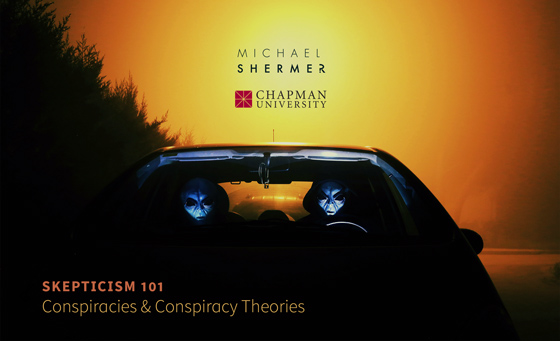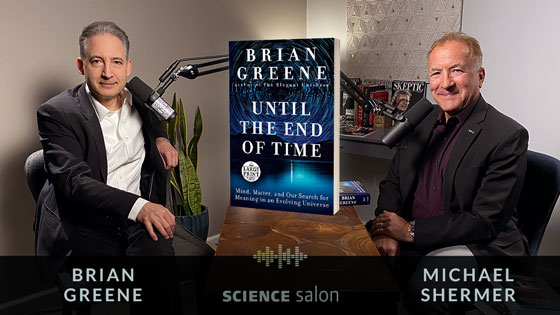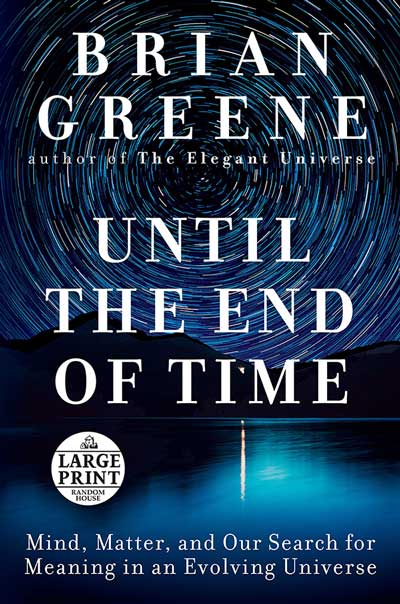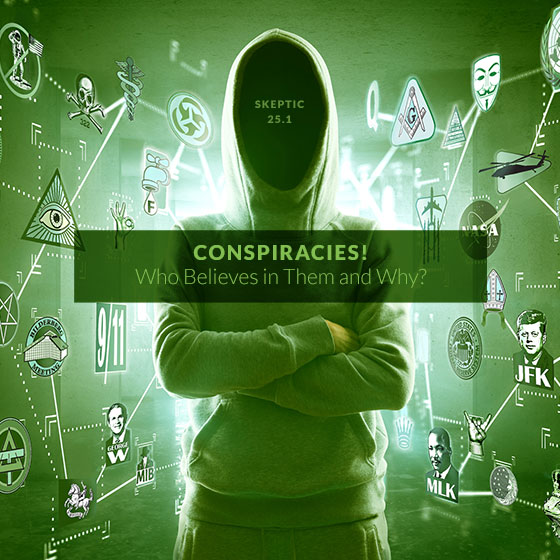SCIENCE SALON # 108
Michael Shermer with Brian Greene — Until the End of Time: Mind, Matter, and Our Search for Meaning in an Evolving Universe
Until the End of Time is Brian Greene’s breathtaking new exploration of the cosmos and our quest to find meaning in the face of this vast expanse. Greene takes us on a journey from the big bang to the end of time, exploring how lasting structures formed, how life and mind emerged, and how we grapple with our existence through narrative, myth, religion, creative expression, science, the quest for truth, and a deep longing for the eternal. From particles to planets, consciousness to creativity, matter to meaning—Brian Greene allows us all to grasp and appreciate our fleeting but utterly exquisite moment in the cosmos.
Dr. Greene is a professor of physics and mathematics and director of Columbia University’s Center for Theoretical Physics and is renowned for his groundbreaking discoveries in superstring theory. He is the author of The Elegant Universe, The Fabric of the Cosmos, and The Hidden Reality, and he has hosted two Peabody and Emmy Award winning NOVA miniseries based on his books. With producer Tracy Day, Greene cofounded the World Science Festival. He lives in New York. Greene and Shermer also discuss:
- God and religion
- why there is something rather than nothing
- What was there before the Big Bang, and what caused it to bang?
- Are mathematics and the laws of nature human constructs or in nature?
- how the 2nd Law of Thermodynamics is the First Law of Life
- How does consciousness arise from physical particles?
- panpsychism
- the Fermi Paradox (where is everybody?)
- the evolutionary origins of storytelling and myth making
- free will and determinism
- finding meaning in a meaningless universe
- Greene’s encounter with J.Z. Knight and her 35,000 year old spirit warrior Ramtha
- Terror Management Theory and the fear of death
- Are moral values human constructs and thus relative, or is there a secular/scientific basis for right and wrong?
Listen to the podcast via Apple Podcasts, Spotify, Google Podcasts, Stitcher, iHeartRadio, and TuneIn.
Check Us Out On YouTube.
Science Salon • Skeptic Presents • All Videos
You play a vital part in our commitment to promote science and reason. If you enjoy the Science Salon Podcast, please show your support by making a donation.
THE GREAT COURSES PLUS
Get unlimited access free for an entire month!
They say knowledge is power. Thanks to The Great Courses Plus we get to tap into this power with just a click. With this streaming service, unlock unlimited access to objective, reliable, fascinating information on virtually any subject. Learn from the brightest minds around the world, benefit from their years of experience and unique insight to help formulate our own knowledge and perspectives, so we can transform from a student into a master! With over 40 thousand 5-Star Reviews on The Great Courses Plus, you’re guaranteed to find compelling content.
Tap into this power of knowledge! Join me — and thousands of other learners — and sign up for The Great Courses Plus. For a limited time only, my listeners will get unlimited access completely free for an entire month! So don’t wait, sign up to start your Free Month Trial today. Simply use my special URL: thegreatcoursesplus.com/salon.

SKEPTICISM 101
Michael Shermer Gives a Remote Lecture on Conspiracies & Conspiracy Theories that anyone can watch for free
During the Coronavirus outbreak, while many schools are closed, Michael Shermer will be teaching remotely his Skepticism 101 course How to Think Like a Scientist from his recording studio in California instead of from Chapman University. He has chosen to share some of these lectures with you that he recorded for his students practicing social distancing at home.
Skepticism 101: How to Think Like a Scientist covers a wide range of topics, from critical thinking, reasoning, rationality, cognitive biases and how thinking goes wrong, and the scientific methods, to actual claims and whether or not there is any truth to them, e.g., ESP, ETIs, UFOs, astrology, channelling, psychics, creationism, Holocaust denial, and especially conspiracy theories and how to think about them.
In this lecture, Dr. Shermer explains the difference between conspiracies and conspiracy theories, who is more likely to believe which conspiracy theories, the social, political, cultural, and psychological conditions in which conspiracy theories flourish, real conspiracies, and who really killed JFK.
The course was 7 weeks into the 15-week semester when the pandemic hit, so this lecture picks up where he was in the course. He thought he would would make these lectures public inasmuch as all of us are now in search of content to consume while we’re stuck inside for the next few months. Enjoy.
Resources mentioned in this lecture
- Skeptic 19.2 — Boston Bombing Conspiracy Theories
- Skeptic 18.3 — 50 Years of JFK Conspiracy Theories
- Skeptic 15.1 — Christian Origins Conspiracy Theory
- Skeptic 12.4 — 9/11 Conspiracy Theories
- Michael Shermer’s Audible Original Course on Conspiracies & Conspiracy Theories
Note: There was a technical glitch at the end of the lecture, cutting out most of the points of the final slides of my Conspiracy Detection Kit. Here are those slide as expanded text:
Conspiracy Detection Kit
Parallel to my Baloney Detection Kit, I have put together a 10-point list for a Conspiracy Detection Kit. The more that a conspiracy theory manifests the following characteristics, the less likely it is to be a real conspiracy.
- Patternicity. Proof of the conspiracy supposedly emerges from a pattern of “connecting the dots” between events that need not be causally connected. When no evidence supports these connections except the allegation of the conspiracy, or when the evidence fits equally well to other patterns—or to randomness—the conspiracy theory is likely false.
- Agenticity. The agents behind the pattern of the conspiracy would need nearly superhuman power to pull it off. Most of the time in most circumstances, people, agencies, and corporations are not nearly so powerful as we think they are. If the conspiracy theory involves super powerful agents it is likely false.
- Complexity. The conspiracy theory is complex and its successful completion demands a large number of elements coming together at just the right moment and in the proper sequence. The more elements involved and the more delicate the timing of the sequence in which they must come together, the less likely the conspiracy theory is to be true.
- People. The more people involved in the conspiracy theory the less likely it is to be true. Conspiracies involving large numbers of people who would all need to keep silent about their secrets typically fail. People are incompetent and emotional. They screw up, chicken out, change their minds, have moral scruples. Conspiracy theories treat people like programmed robots carrying out their commands. That is unrealistic.
- Grandiosity. If the conspiracy theory encompasses some grandiose ambition for control over a nation, economy, or political system, and especially if it aims for world domination, it is almost certainly false. The bigger the conspiracy the more likely it is to fail for the reasons of complexity and people that I’ve just given.
- Scale. When the conspiracy theory ratchets up from small events that might be true to much larger events that have much lower probabilities of being true, it is very likely false. Most real conspiracies involve very specific events and targets, such as insider trading on Wall Street, price fixing in an industry, tax evasion by a corporation, and, yes, the assassination of a political leader, but always for a narrow goal of making money, grabbing power, or ending tyranny.
- Significance. If the conspiracy theory assigns portentous and sinister meanings and interpretations to apparently innocuous or insignificant events, it is most likely false. Again, most conspiracies are narrowly focused and significant only to those who will benefit or be hurt. Most real conspiracies do not change the world.
- Accuracy. If the conspiracy theory commingles facts and speculations without distinguishing between the two, it is likely to be false. Conspiracists are notorious for sprinkling in a handful of verifiable facts amidst a vast array of conjectures and suppositions, which blur reality and confuse listeners into thinking there is more to the theory than there actually is.
- Paranoia. If a conspiracy theorist is extremely and indiscriminately suspicious of any and all government agencies or private corporations, this suggests a lack of nuance in understanding how the world works. Yes, sometimes “they” really are out to get you, but usually not.
- Falsifiability. Conspiracy theorists typically refuse to consider alternative explanations, rejecting all disconfirming evidence for the theory, and blatantly seeking only confirming evidence to support what has a priori been determined as the truth. To return to Karl Popper, if a conspiracy theory cannot be falsified, it is probably false.
SKEPTIC 25.1
Order the print edition, or download the digital edition today!
Who believes in conspiracies and why? Read real conspiracy theories and conspiracies with no theories in Skeptic magazine 25.1, available now in print and digital formats.
30-DAY FREE TRIAL : We offer a 30-day free trial to new digital subscribers on annual subscriptions within the Skeptic Magazine App for iOS and Android devices.












